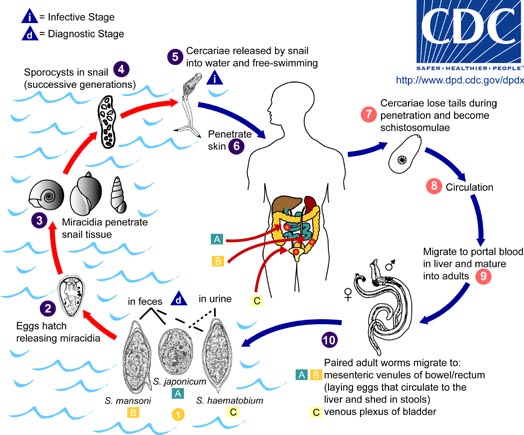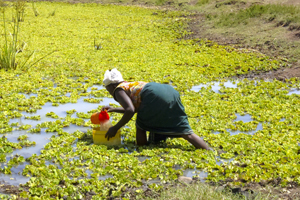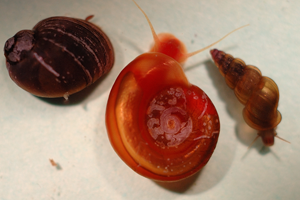Quick Facts
|
|
|
|
Schistosomiasis is a parasitic worm disease with most infections caused by Schistosoma mansoni, S. haematobium and S. japonicum. These worms can live for many years in the veins associated with the liver, intestines (S. mansoni and S. japonicum) or bladder (S. haematobium) with each female laying tens of thousands of eggs over its life time. Symptoms of chronic schistosomiasis include anemia, fatigue, abdominal pain, diarrhea, and in advanced cases granuloma formation due to trapped eggs that may lead to an enlarged liver and spleen and obstruction to the hepatic portal system. While adults might find it difficult to work, for many children infection results in delayed development and learning difficulties at school. With S. haematobium there is also a significantly elevated risk of bladder cancer. Schistosomiasis has been treated with the anthelmintic drug praziquantel for over 40 years with most side effects associated with drug treatment being attributable to the release of parasite antigens on worm death. Though there is little evidence of sustained drug resistance, the potential loss of the only effective widely available schistosomicidal drug as the number of patients treated accelerates is concerning and underscores the need to develop new drugs or improve old ones.
What is it?
Schistosomiasis is a complex disease that requires both a freshwater snail and human host for propagation of the parasite. Mating of male and female schistosomes in the blood of the human produces many thousands of eggs that migrate through the intestine (S. mansoni and S. japonicum) or bladder wall (S. haematobium) and are excreted in the feces or urine respectively. On contacting fresh water the eggs hatch releasing miracidia that infect aquatic snails. After several weeks and several rounds of reproduction within the snail resulting in the production of first sporocytes and then cercariae, several thousand cercariae will be released from a single snail. Humans contract schistosomiasis while in streams and lakes that harbor snails shedding these cercariae. Cercariae swim towards and penetrate human skin at which point they transform into schistosomula and migrate through the vascular system to the hepatic portal, mesenteric or bladder veins. Once they reach sexual maturity males and females mate, egg production begins and the life-cycle continues. Schistosome life cycle animation from The Wellcome Trust can be found here.

Where does it occur?
 Schistosomiasis occurs in Africa, the Middle East, parts of the Caribbean, South America, China and South East Asia often in rural areas that lack basic sanitation. Approximately 700 million people are at risk of contracting the disease with at least 200 million infected. More than 90% of cases occur in sub-Saharan Africa. Travelers to areas endemic for the disease can also contract the disease if they swim or bathe in infected water.
Schistosomiasis occurs in Africa, the Middle East, parts of the Caribbean, South America, China and South East Asia often in rural areas that lack basic sanitation. Approximately 700 million people are at risk of contracting the disease with at least 200 million infected. More than 90% of cases occur in sub-Saharan Africa. Travelers to areas endemic for the disease can also contract the disease if they swim or bathe in infected water.


